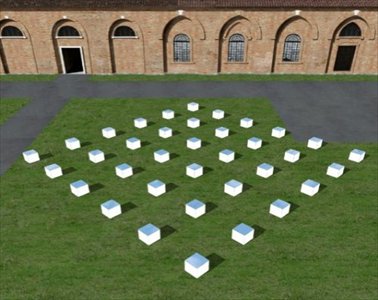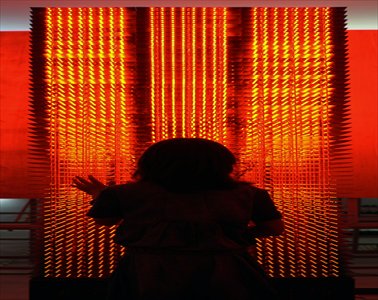Common Ground celebration


It is another bustling season in Venice, with the Biennale coming soon. The Venice Biennale will organize a number of international events for the contemporary arts throughout the summer.
This year, led by art and architecture critic Fang Zhenning, five Chinese artists and architects will attend the 13th International Architecture Exhibition from August 29 to November 25 in Venice.
2012 Biennale
The 2012 exhibition, titled Common Ground, is directed by David Chipperfield, known for his design of the New National Gallery in Berlin. The exhibition will be complemented by 55 national participants. Exhibitions and initiatives will be held in various locations around the city. Countries including Angola, Kuwait, and Peru will be participating for the first time.
"The emphasis of the 2012 Biennale is what we have in common,'" Chipperfield posted on the official Venice Biennale website.
Common Ground consists of a single exhibition through the Central Pavilion at the Giardini and the Arsenale, where David Chipperfield will present an exhibition of 61 projects by architects, photographers, artists, critics and scholars.
"The ambition of Common Ground is to reassert the existence of an architectural culture, made up not just of singular talents but a rich continuity of diverse ideas united in a common history, common ambitions, common predicaments and ideals," Chipperfield wrote on the official website.
China Pavilion
Fang Zhenning, the curator of the China Pavilion, told the Global Times that Chipperfield has a minimalist approach, preferring things reduced to only the necessary elements. As the economic situation in Europe has stagnated since the financial crisis in 2008, exaggerated styles and expensive materials are not suitable options given the present situation.
The theme for the China Pavilion this year will be "originaire," or origin. Fang came up with the idea of finding and presenting various sides of the origin of human civilization. The Chinese team will use a simple and philosophical way to discuss the essence of architecture.
Thus far, the Chinese team has almost finished their preparations. Their work will be shipped to Italy and reconstructed in the exhibition area.
The five projects arriving in Venice are Square Garden from architect Wang Yun, Palace in the Sky by female artist Tao Na, Cluster from architect Shao Weiping, Lightopia from space designer Xu Dongliang and Variation from architect Wei Chunyu. These projects have all been assessed by seven national experts in the architecture and arts industry.
In the creation process, the artists drew inspiration from mathematics, anthropology, Chinese philosophy, and other arenas. Each project represents an origin in human civilization.
Square Garden alludes to the foundation of architecture. Cluster borrows from the mathematical Mobius strip. Lightopia, combining the words "utopia" and "light," suggests that fire and lights cultivated tribes, civilizations and social development. Variation applies the idea of prime numbers to represent changes of time and space. Palace of the Sky is an interactive screen which contains scenes of Beijing, Mars and the Milky Way. It argues that during this period of space development, it is necessary to remember earth as our origins.
Team preparation
The trip is not easy for the Chinese team. The rental price of the exhibition for three months is about 1.08 million yuan ($169,900). The Ministry of Culture of the People's Republic of China provided 1 million yuan for the Chinese team, and the China Arts and Entertainment Group will take the responsibility of advertisement and marketing. The remaining costs, such as materials and transportation, are left to the team members.
"The theme Common Ground goes beyond national styles," said Fang.
Instead of using obvious Chinese elements, artists integrated Chinese traditions in their design. Square Garden for example, has its angle aligned directly to north, south, east and west, in accordance to the Chinese phrase tianyuan difang, which literally means that the sky is round; the earth is square.
The design and artistic representations do not particularly look Chinese in the stereotypical way.
But they are full of Chinese ideas and express the spirit and disposition of Chinese culture in a profound way," said Fang. He said that the best way to inherit cultural heritage and traditional techniques is to combine them with modern ideas and designs.
Fang attended almost every International Architecture Exhibitions since 2000. "You [must] understand the condition of the exhibition space in Venice to solve technical problems," Fang said.
Speaking about his role as an independent curator of the exhibition, Fang likens his position to a film director.
"This is a relatively new job in China," Fang said. To be a qualified curator requires multiple talents, including a solid understanding of arts and design, social networks and financial resources.
He hopes the China Pavilion will showcase the talents of Chinese artists and architects to the world.
In the urbanization process, the development of architecture institutions is key. But at the moment, there is still a lack of architecture tradition and common values in China.
"Constructions are social acts and thus also cultural issues," said Cao Xiaoxin, an architect from China Architecture Design and Research Group.
Cao said that architecture culture is a broad topic which involves a whole industrial chain, involving management, technology, energy resources and urban planning.
For China to develop its culture and cities, it is necessary to provide the world a glimpse into domestic architectural values.